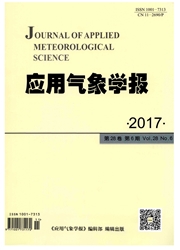

 中文摘要:
中文摘要:
静止气象卫星的快速区域扫描是监测不同天气过程的有利手段。以获取的风云静止气象卫星快速区域扫描数据为基础,选取2011年台风梅花(1109)及2012年台风海葵(1211)的观测数据,采用Hovm611er分析图、变异系数等参数,研究不同时空分辨率观测数据对台风云系结构特征参数监测的敏感性影响。分析结果表明:可见光通道10min观测时间间隔配以1.25km空间分辨率可以很好地反映云系演变特征,在相同观测时间分辨率条件下,降低空间分辨率会对云系结构特征的提取有较大影响;在相同空间分辨率条件下,观测时间分辨率的降低对云系结构及演变特征的分析影响较小;基于变异系数的分析说明云像元特性在60min的观测时间间隔下发生了较大变化,如果以60min为观测时间间隔将会失去较多的云像元变化特征。水汽通道不同观测时间的变异系数差值小于红外通道1,说明云像元在红外通道1的特性演变对观测时间的敏感性高于水汽通道,提高观测频率可获取更多的云像元红外通道1的辐射特性。
 英文摘要:
英文摘要:
The traditional obervation interval of Fengyun geostationary meteorological series satellite is 1 hour for a single satellite. During flooding season, the obervation frequency is imporived to half an hour. Doub- le satellite observation mode can provide remote sensing data every 15 minutes. Due to the difference of ob- servation angles and calibration error between different satellites, remote sensing data sometimes appear consistency and uniformity deviation. So improving observation frequency for a single satellite is the best way to get high quality remote sensing data. Rapid scan mode of geostationary meteorological satellites is an important method to monitor all kinds of weather processes. National Satellite Meteorological Center uses retired FY-2C satellite to carry out high frequency rapid regional scan observation trials and get continuous data with an average of 10-minute interval. Based on high frequency observations, Hovm611er diagram and coefficient of variation are used to analyze the sensi- tivity of multi-scale satellite data on monitoring the structure of a strong typhoon Muifa(2011). The research results show that the high frequency observations can clearly demonstrate the evolution of a strong typhoon cloud structure. Each channel with different spatial and temporal resolution has differ- ent sensitiveness in monitoring the structure feature of cloud. Reflectivity at visible channel with 1.25-kilometer spatial resolution and 10-minute temporal resoution can well show features of typhoon cloud. Under the same observation temporal resolution condition, lowering spatial resolution has great im- pact on monitoring the structure of cloud. If the spatial resolution keeps the same, reduced observation temporal resolution has less effect on extracting the characteristics of clouds. Using Hovm611er diagram to compare cloud brightness temperature characteristics through infrared window channel under different temporal resolution, it can be seen that there is no great difference between 10-minute an
 同期刊论文项目
同期刊论文项目
 同项目期刊论文
同项目期刊论文
 期刊信息
期刊信息
